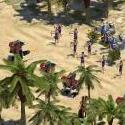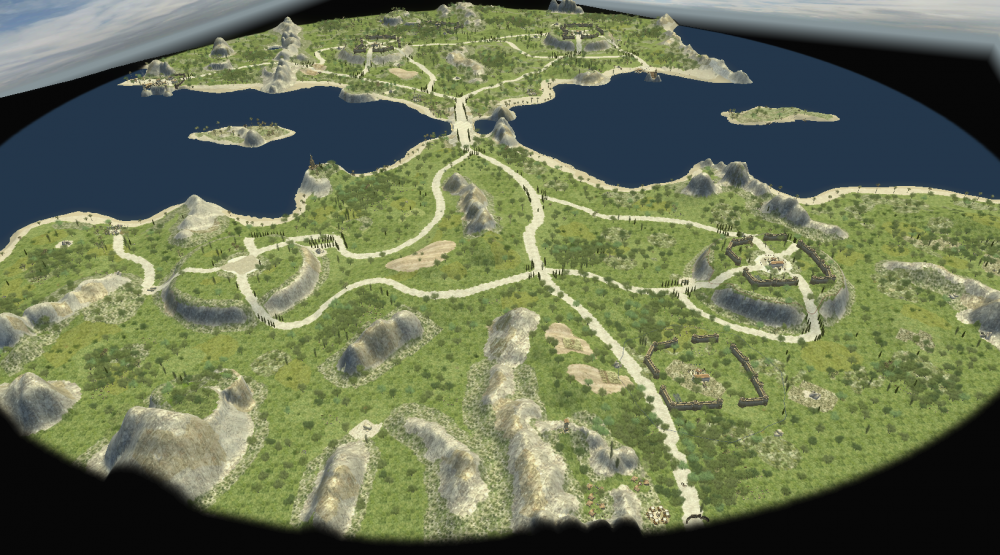Leaderboard
Popular Content
Showing content with the highest reputation on 2020-09-11 in all areas
-
So, DE has a feature called Groves, which are collections of trees which are 1 large selectable and gatherable object. There's a few interesting things you can do with this, like make an "underbrush" aura which makes units move slower through them, have less accuracy while shooting in them, etc. Also, as one selectable object you have fewer things to keep track of and also conceptually they make sense in that forests were valuable sources of resources, not just individual trees. There are still individual trees (stragglers), but they aren't the sole source or primary source of wood, the groves are your primary source of wood. Now, also in DE you can build Storehouses and Farmsteads outside your territory. This creates a soft concept of "weak countryside; strong city", where a lot of raiding happens outside of the home territories of the players. But instead of suggesting EA adopt DE's features, I've come up with something specifically unique that the core game could adopt. It takes the DE concepts and pushes them forward a bit. So, imagine the map has these Forests and Farmland areas. Forests would be a collection of large wood-bearing objects similar to DE's groves with a Gaia Lumber Camp nearby, while Farmlands would be large open areas of furrowed land terrain with a Gaia Farmstead nearby or centralized to it. The basic game still doesn't let you build Storehouses or Farmsteads (I would rename the player-built object to Granary to distinguish) outside your territory, but it does let you capture these Lumber Camps and Farmsteads which are outside your territory. (the overall concept is similar to the capturing Stone Quarries and Metal Mines idea, which are resource bearing objects outside your home territory). So, instead of the old "slotting" concept, you just capture these Lumber Camps and Farmsteads which are already there. Forests become "renewable" sources of wood (it regenerates wood over time if not reduced to 0), but slower to gather than individual straggler trees (which don't renew) that you find inside your home territory. You can still build farms in your home territory, but those on the Farmlands are much more productive. Lumber Camp mockup: Capture the Lumber Camp dropsite (Yellow) and now you can gather wood outside your territory. Forests are made up of Groves (Red-cartouche footprint; Blue-circle footprint) and can be depleted, but they regenerate wood over time, faster if left alone. Groves have other attributes, such as they can be "garrisoned" by some civs' soldiers for an ambush effect, and they also have auras that cause units to have lower vision and movement speeds within their footprints. Straggler Trees (Green) are gatherable, but do not regenerate and can be built over by player structures (the tree disappears).1 point
-
1 point
-
This is a lightly modified version of the Corinthian Isthmus skirmish map. It puts players 1 & 2 next to each other, and adds an extra player to the other side. aa2020-5-modified-Corinthian Isthmus_5p.xml aa2020-5-modified-Corinthian Isthmus_5p.pmp https://github.com/andy5995/0ad-maps/tree/trunk/maps/skirmishes1 point
-
That's it. Projectiles (mostly) don't have a trajectory from the simulation point of view, they are just distant delayed hit. Then a trajectory is rendered. The choice was a parabolic trajectory. <Gravity> is the graphical parameter which will adjust the height of the parabola. For now, artists have to tweak that so it fits what they want to see. Don't bother with anything else. More have to be said, but not enough place on that margin.1 point
-
You might enjoy the team placement helper on balanced-maps. It groups players into teams and places them as vertices of polygons facing each other. You can see this placement in action on slopes and balanced hyrcanian shores.1 point
-
I like the original DE concept better, farmstead and storehouses outside of territory does not seem bad. Having territory allows you to protect it better, so it's still encouraged for taking map control. At the same time allows for players using heavy mineral dependent civilizations to not be too far behind if the map gen is not generous, encourages players to constantly scout or make outposts on resource dense spots which is a plus in my opinion. Capturing a stray farmstead or storehouse could make some sense but it feel out of place in my opinion. Farmlands + forests would be awesome1 point
-
Personally, I'm against the idea of combining civs and against the idea of civ brackets/tiers. I think we are all thinking about this is the wrong way. We don't need to be thinking about the factions as a group. In fact, that's the one aspect of this game we should be ignoring. Scenario Think of a matchup between Britons and Seleucids. Each faction is quite different from one another. However in this matchup, it is not very important to compare the two civilizations in terms of historical accuracy. We should be comparing them based on the environment. Each culture developed a style of warfare that best suited their environment In a heavy wooded map, the more flexible Britons have an advantage over the large and clumsy formations of the Seleucids, but in an grassland, the tables flip. Now the powerful Seleucid formations and cavalry would shred the Britons. Conclusion We need to be thinking more about the environment that we put the civilizations in. More deliberate map design, with areas that all factions can excel in. Currently, our maps are based on locales, which is hindering balance by favoring the native culture. Thinking about the scenario above, imagine a map with both heavily wooded areas, and open areas/ pathways. Now the question doesn't become which faction is better, it becomes a question of how well can each player utilize the map! How well can they force engagements on terrain that favors them? Obviously we would still need to keep an eye on the exact stats of techs and units for each faction, but if we build the maps right, we can still allow these unique matchups that make this game great! Open areas for the more formation focused civs, wooded areas/rough terrain for more flexible civs. Flat areas for cavalry civs, and terrain height for ranged based civs. Most RTS titles focus on how well you can micro your economy and armies, but map utilization is rather minor. Players usually play "on" the map instead of "with it!" This is what could give 0AD an identity and make it unique from other RTS titles! As an added bonus, it would allow for more factions to be added without making balancing a nightmare! Addendum Now, we still need to consider the factions as individuals. I'm of the opinion that we should make sure that each one feels unique. We don't need Starcraft-ien levels of unique, but think AOEIII WOL mod levels of unique. Each faction should have a preferred playstyle and a preferred unit roster, and it's out goal as balancers to make sure to emphasize these preferences. Spartans should be a infantry heavy faction, Carthage should play defensively, Kush can build tall, and the Seleucids can build wide. By emphasizing these preferences, players can really get a feel for the differences of each faction, and they can find the one that matches their playstyle. This can be done through more unique techs, faction bonuses, and possibly with re-thought rosters. Combining all these thoughts would make this game a great game of tactical skill. The player must not only take advantage of their civ's unique strengths and understand their weaknesses, but use the map and the environment to help make sure they fight on their terms.1 point
-
This is a helpful distinction "Many Civilizations, slightly different; few Civilizations, very different." Here's how I might suggest integrating different Civilizations. Every smaller Civilization has a larger category, for example, the "culture" mechanic already exists. "Hele" being Macedonian, Spartan, Athenian, etc. Within each such cultural group, use the phrase "Many Civilizations, slightly different". But when comparing to other cultures, such as the Persians, use the phrase "Fewer Civilizations, very different." There is another way, which is much more powerful long term as the number of mechanics and Civilizations multiplies so balancing becomes exponentially complex(balancing civs is at least an n2 problem). The bonuses that each Civilization, including build tree, are specified in a rating system. Example: Cost Abilities 10% decrease in Infantry Cost: 10 points 20% decrease in Infantry Cost: 25 points Build Tree Abilities Spearmen Available in Village Phase: 5 points Swordsmen Available in Village Phase: 7points Champion Class Available in Town Phase: 10 points This way every Civilization will have a point rating. Ideally, unit stats will then be calculated algorithimically based on these bonuses. If time is spent on giving a cardinal(numerical) rating to every possible civilization statistic, we would have a powerful rating system to specify which civilizations are stronger or weaker. If we algorithimicaly generate the stat files, the players could even specify in a pregame option whether they want "realistic" or "playable" civilizations. Eg the "Nuba" minifaction in Delenda Est wont realistically be able to withstand the might of the Roman Imperial Army. But it might be fun to pretend that it can :-)1 point





